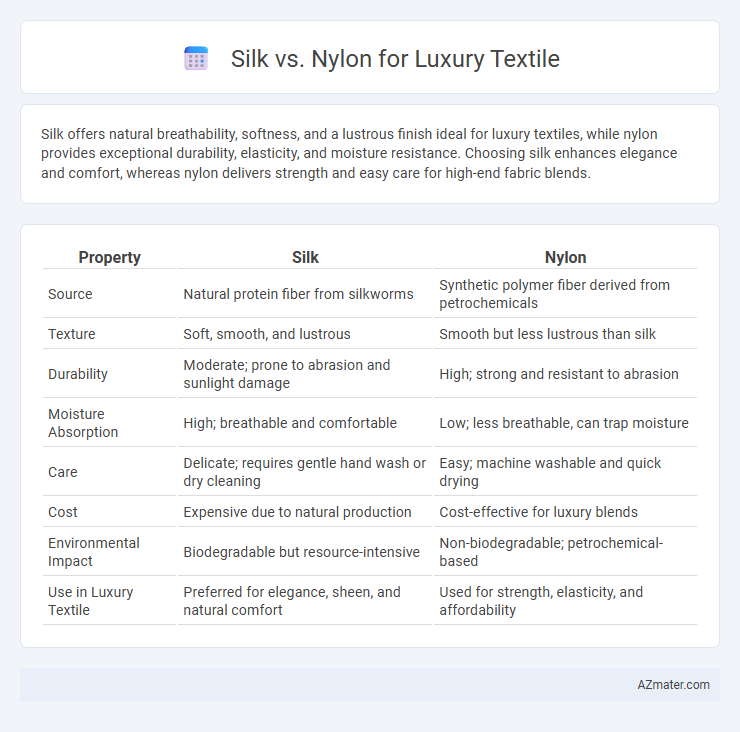Silk offers natural breathability, softness, and a lustrous finish ideal for luxury textiles, while nylon provides exceptional durability, elasticity, and moisture resistance. Choosing silk enhances elegance and comfort, whereas nylon delivers strength and easy care for high-end fabric blends.
Table of Comparison
| Property | Silk | Nylon |
|---|---|---|
| Source | Natural protein fiber from silkworms | Synthetic polymer fiber derived from petrochemicals |
| Texture | Soft, smooth, and lustrous | Smooth but less lustrous than silk |
| Durability | Moderate; prone to abrasion and sunlight damage | High; strong and resistant to abrasion |
| Moisture Absorption | High; breathable and comfortable | Low; less breathable, can trap moisture |
| Care | Delicate; requires gentle hand wash or dry cleaning | Easy; machine washable and quick drying |
| Cost | Expensive due to natural production | Cost-effective for luxury blends |
| Environmental Impact | Biodegradable but resource-intensive | Non-biodegradable; petrochemical-based |
| Use in Luxury Textile | Preferred for elegance, sheen, and natural comfort | Used for strength, elasticity, and affordability |
Introduction to Silk and Nylon in Luxury Textiles
Silk offers unparalleled softness, natural sheen, and breathability, making it a coveted fiber in luxury textiles for high-end garments and upholstery. Nylon, a synthetic polymer, provides exceptional strength, elasticity, and resistance to abrasion, often blended with natural fibers to enhance durability and maintain a refined appearance. The combination of silk's natural elegance with nylon's resilience creates innovative luxury fabrics that balance comfort with long-lasting performance.
Origin and Production Processes
Silk, derived from the cocoon of the Bombyx mori silkworm, involves a delicate harvesting and reeling process that has been refined over thousands of years, emphasizing natural fiber extraction and handcrafting techniques. Nylon, a synthetic polymer invented in the 1930s through chemical synthesis of petroleum-based compounds, undergoes an industrial manufacturing process involving polymerization, spinning, and drawing to create durable, uniform fibers. The origin of silk as a natural protein fiber contrasts sharply with nylon's synthetic origin, reflecting differences in sustainability, texture, and luxury perception in textile production.
Fiber Structure and Physical Properties
Silk fibers are composed of fibroin protein with a triangular prism-like structure, providing natural luster, smoothness, and excellent drape, while nylon is a synthetic polyamide with a round cross-section that offers high strength and elasticity but lacks inherent sheen. The crystalline regions in silk contribute to its breathability and moisture-wicking properties, making it ideal for luxury textiles where comfort intersects with elegance. Nylon's durability and resistance to abrasion enhance longevity but result in less softness and warmth compared to the naturally insulating properties of silk fibers.
Aesthetic Appeal: Texture and Sheen
Silk offers a natural sheen and smooth texture that exudes luxury and elegance, making it highly prized in high-end textiles. Nylon, while durable and versatile, lacks the subtle luster and soft handfeel of silk, often presenting a more synthetic appearance. The tactile richness and radiant glow of silk significantly enhance the aesthetic appeal of luxury garments and accessories compared to nylon.
Comfort and Wearability
Silk offers exceptional comfort in luxury textiles due to its natural breathability, moisture-wicking properties, and smooth texture that feels gentle against the skin. Nylon, while durable and resistant to wrinkles, lacks the same level of breathability and can cause discomfort in warm or humid conditions. Luxury garments crafted with silk provide superior wearability through temperature regulation and hypoallergenic qualities, making it the preferred choice for high-end apparel focused on comfort.
Durability and Longevity
Silk offers a natural fiber renowned for its luxurious sheen and softness but is less durable and prone to damage from abrasion and moisture. Nylon, a synthetic fiber, provides superior strength, resistance to wear and tear, and longer-lasting performance in luxury textiles. For longevity, nylon-based fabrics maintain structural integrity over time, making them more practical for high-use luxury applications compared to delicate silk.
Environmental Impact and Sustainability
Silk, a natural protein fiber produced by silkworms, offers biodegradability and a lower carbon footprint compared to synthetic nylon, which is derived from petrochemicals and contributes to microplastic pollution. The cultivation of mulberry trees for silk supports soil health and biodiversity, whereas nylon manufacturing relies heavily on fossil fuels and releases significant greenhouse gases. Sustainable luxury textile brands prioritize silk for its renewable sourcing and reduced environmental impact, aligning with eco-friendly consumer values.
Cost Comparison in the Luxury Market
Silk commands a significantly higher price in the luxury textile market due to its natural origin, superior luster, and labor-intensive production process, with costs often ranging from $20 to $100 per yard. Nylon, a synthetic fiber, is considerably more affordable, typically priced between $5 and $15 per yard, making it a budget-friendly alternative but lacking the premium qualities associated with silk. Luxury brands weigh these cost disparities carefully, as silk's exclusivity justifies its premium pricing despite higher expenses in sourcing and craftsmanship.
Popular Applications in High-End Fashion
Silk is favored in high-end fashion for its natural luster, softness, and breathable quality, making it ideal for luxury gowns, scarves, and evening wear that demand elegance and comfort. Nylon, though synthetic, is prized for its durability, elasticity, and resistance to wrinkles, often used in luxury activewear, lingerie, and outerwear where performance and a sleek finish are essential. Designers typically choose silk for items emphasizing luxury and tactile richness, while nylon is selected for innovative, functional pieces that require strength and stretch.
Choosing Between Silk and Nylon: Key Considerations
Choosing between silk and nylon for luxury textiles involves evaluating factors such as texture, durability, and breathability. Silk offers unmatched softness, natural hypoallergenic properties, and elegant sheen ideal for high-end garments, while nylon provides superior strength, moisture-wicking capabilities, and greater resistance to wrinkles and abrasions. Consider care requirements and environmental impact, as silk requires delicate handling and is biodegradable, whereas nylon is more resilient but derived from synthetic polymers.

Infographic: Silk vs Nylon for Luxury textile
 azmater.com
azmater.com